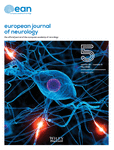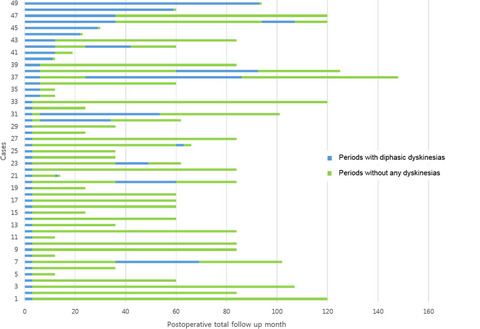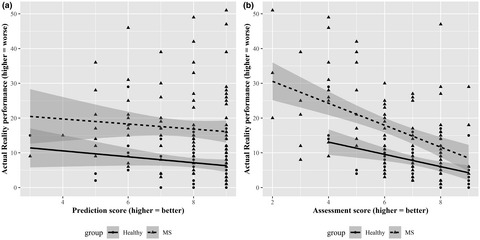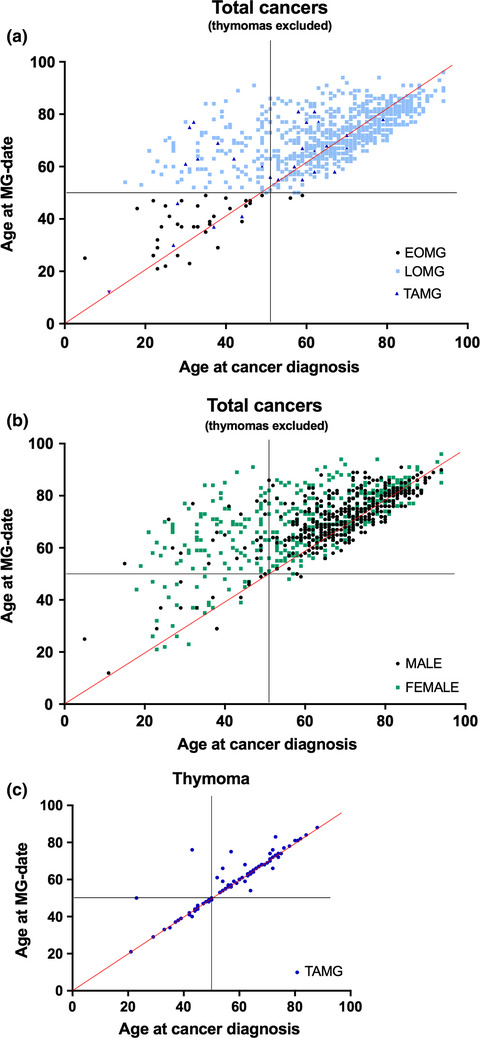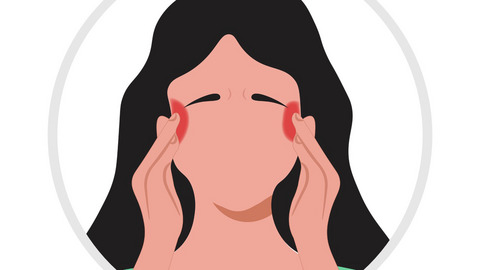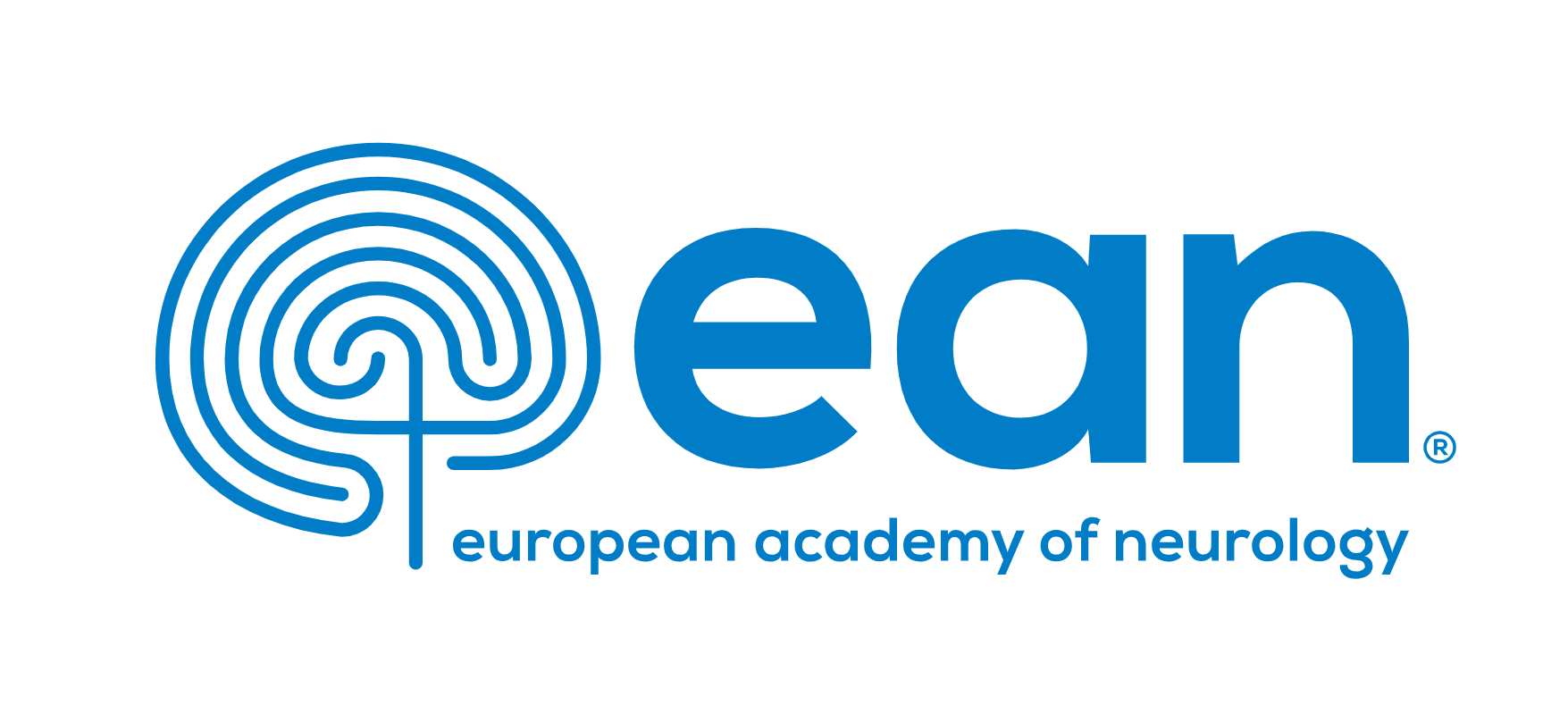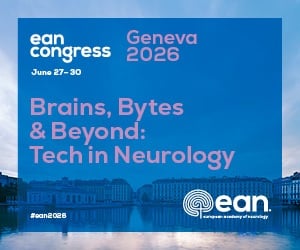Journal list menu
Export Citations
Download PDFs
Issue Information
Muscle and MNJ Disorders
From many, one: A call for meta-cohorts in neuromuscular ultrasound
- Pages: 1435-1436
- First Published: 09 February 2021
Vestibular disorders
Is the bedside head impulse test useful in emergency decision making for nonexpert routine clinical practice?
- Pages: 1437-1438
- First Published: 01 February 2021
Headache
The paradigm shift in long-term treatments for migraine prevention
- Pages: 1439-1440
- First Published: 12 February 2021
All neurologists
Functional neurological disorders presenting as emergencies to secondary care
- Pages: 1441-1445
- First Published: 11 January 2021
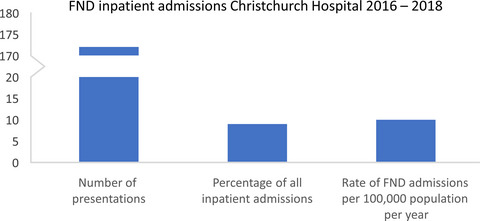
Figure labelled graphical abstract in file upload section. This is a figure created solely for the graphical table of contents. Functional neurological disorders (FND) represent a significant proportion of presentations to adult neurology services. We identified patients presenting as acute admissions with FND to Christchurch Hospital, Christchurch, New Zealand, from 2016 to 2018. 162 patients presented on 173 occasions with FND, representing 9% of all admissions to the neurology service during the 3-year study period. The rate of acute inpatient admission for FND was 10 per 100,000 per year for the total Christchurch Hospital catchment.
Status of clinical research in neurology in Germany—A national survey
- Pages: 1446-1452
- First Published: 04 February 2021
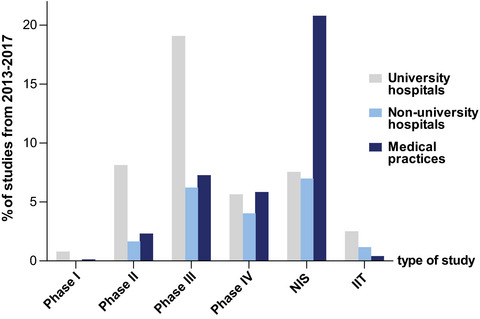
Because in Germany there has so far been little available information on the actual status of clinical research in neurology, we created a focused questionnaire to give a comprehensive overview of participation of national neurology departments in hospitals and neurological outpatient practices in the conduction of clinical trials. Our report should help to identify issues in the process of conducting clinical trials and discuss possible solutions. Our results indicate that there is a lack of instruments of quality assurance and the need for structured support and encouragement for young physicians to initiate innovative clinical research.
Epilepsy
Video quality using outpatient smartphone videos in epilepsy: Results from the OSmartViE study
- Pages: 1453-1462
- First Published: 19 January 2021
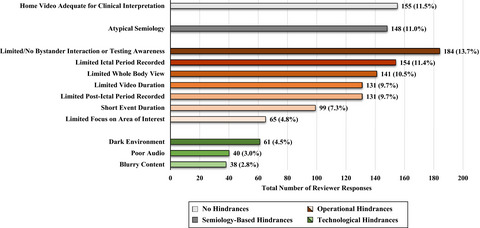
Smartphone video quality is adequate for clinical interpretation in the majority of patients with paroxysmal neurological events. Encouraging patient interactivity, 2 min duration, and use of enlarged fields of view during smartphone videography will minimize technological hindrances and maximize quality for ES and PNEA SV recording.
Mozart effect in epilepsy: Why is Mozart better than Haydn? Acoustic qualities-based analysis of stereoelectroencephalography
- Pages: 1463-1469
- First Published: 01 February 2021
Dementia and cognitive disorder
Association between sleep disturbance with motoric cognitive risk syndrome in Chinese older adults
- Pages: 1470-1478
- First Published: 14 December 2020
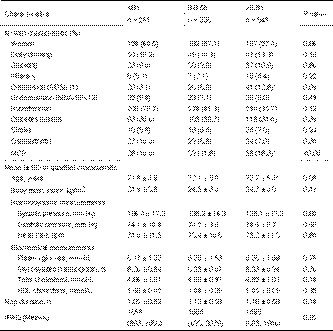
Compared to shorter night-sleep duration (<8 h), longer night-sleep duration (>8.5 h) was associated with motoric cognitive risk (MCR) syndrome (odds ratio, 2.03; p = 0.02). Poor sleep quality and taking sleep drugs were also associated with higher odds of having MCR syndrome in the community-dwelling elderly Chinese population.
Head-to-head comparison of amplified plasmonic exosome Aβ42 platform and single-molecule array immunoassay in a memory clinic cohort
- Pages: 1479-1489
- First Published: 28 December 2020
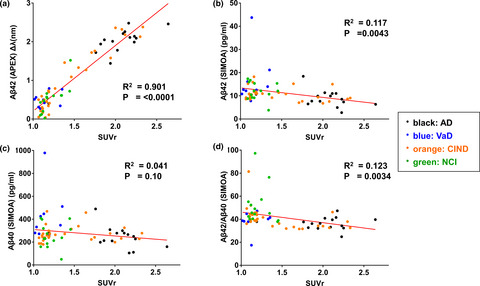
Amplified plasmonic exosome (APEX) Aβ42 and single-molecule array (Simoa) Aβ42/Aβ42 can efficiently enrich clinical trials with amyloid positive (Aβ+) participants whilst halving recruitment cost. With its good diagnostic performance, APEX is the ideal candidate for Aβ+ subject identification and monitoring and for primary care screening.
Relationships between retinal layer thickness and brain volumes in the UK Biobank cohort
- Pages: 1490-1498
- First Published: 28 December 2020
Indicators of dementia disease progression in primary care: An electronic health record cohort study
- Pages: 1499-1510
- First Published: 30 December 2020
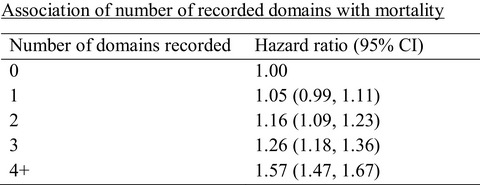
This study examined the feasibility and validity of using information recorded in primary care records as indicators of dementia progression. The indicators were nested in 13 domains, and having a higher number of newly recorded domains was associated with recognised outcomes (hospital admission, palliative care, mortality). These indicators may help identify patients with poorer prognosis in order to improve outcomes through stratified care and targeted support.
[18F]FDG PET may differentiate cerebral amyloid angiopathy from Alzheimer’s disease
- Pages: 1511-1519
- First Published: 18 January 2021
![[18F]FDG PET may differentiate cerebral amyloid angiopathy from Alzheimer’s disease](/cms/asset/7b626279-8e69-4ded-8d25-daf47f4dccef/ene14743-toc-0001-m.jpg)
Cerebral amyloid angiopathy (CAA) is a frequent cause of both intracerebral hemorrhage (ICH) and cognitive impairment in the elderly. Although amyloid positron emission tomography (PET) is positive in most patients with CAA, differentiation from Alzheimer’s disease (AD) may be difficult. We show here that the occipital/posterior cingulate tracer uptake ratio using fluorodeoxyglucose (FDG) PET is significantly lower in probable CAA patients than in AD patients without magnetic resonance imaging markers of CAA, consistent with the known distribution of pathological and FDG markers in both conditions. Larger prospective studies, including in CAA-related ICH, are warranted to confirm these findings and assess their clinical utility.
The cerebellum could serve as a potential imaging biomarker of dementia conversion in patients with amyloid-negative amnestic mild cognitive impairment
- Pages: 1520-1527
- First Published: 08 February 2021
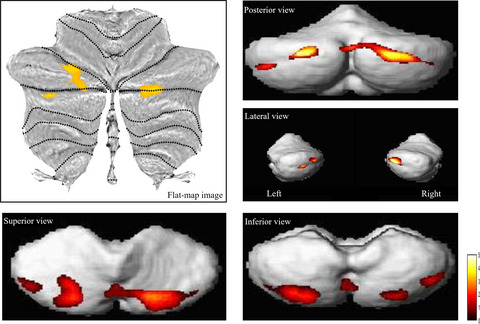
The change of cerebellar gray matter volume could serve as an early marker of neurodegeneration in amnestic mild cognitive impairment (MCI) with no amyloid deposition. A significant cerebellar gray matter volume reduction was observed in the bilateral crus I/II in those who converted to dementia from amyloid-negative amnestic MCI. This finding may be a novel imaging biomarker for predicting disease progression in amyloid-negative amnestic MCI patients.
ALS and frontotemporal dementia
Structural and functional underpinnings of precentral abnormalities in amyotrophic lateral sclerosis
- Pages: 1528-1536
- First Published: 06 January 2021

Structural and functional underpinnings of precentral abnormalities in amyotrophic lateral sclerosis (ALS) remain unclear. Using multimodal magnetic resonance imaging data, this study reported that patients with ALS had decreases in precentral cortical thickness, self-inhibition, and fractional anisotropy of the tracts connected to the precentral gyrus.
Movement Disorders
Brain connectivity abnormalities and treatment-induced restorations in patients with cervical dystonia
- Pages: 1537-1547
- First Published: 22 December 2020
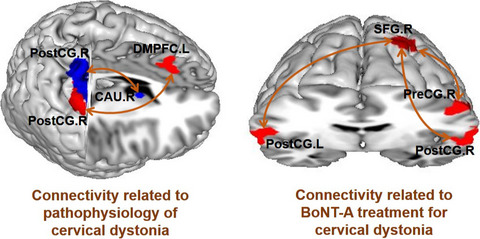
Our findings have uncovered dissociable connectivity of the sensorimotor cortex underlying the pathology of cervical dystonia (CD) and central effects of botulinum toxin type A (BoNT-A) therapy. For CD patients baseline connectivity of the right postcentral gyrus with the left dorsomedial prefrontal cortex and right caudate nucleus was elevated and associated with their symptom severity. BoNT-A reduced excessive functional connectivity between the sensorimotor cortex and right superior frontal gyrus, which was significantly correlated with symptom improvement.
Botulinum toxin injection into the intrinsic laryngeal muscles to treat spasmodic dysphonia: A multicenter, placebo-controlled, randomized, double-blinded, parallel-group comparison/open-label clinical trial
- Pages: 1548-1556
- First Published: 04 January 2021
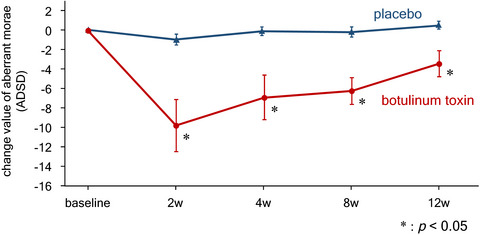
The number of aberrant morae (phonemes) decreased significantly at 2 to 12 weeks after botulinum toxin injection into the thyroarytenoid muscle in patients with adductor spasmodic dysphonia, whereas the placebo group showed insignificant change. This study showed the significant effectiveness of botulinum toxin therapy for spasmodic dysphonia.
The longevity gene Klotho and its cerebrospinal fluid protein profiles as a modifier for Parkinson´s disease
- Pages: 1557-1565
- First Published: 15 January 2021
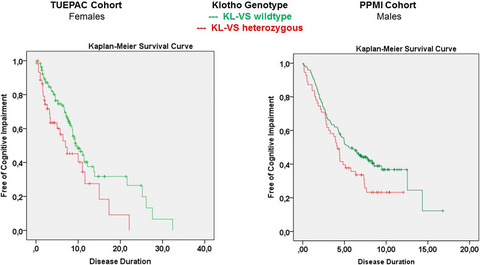
Low CSF levels of the longevity protein Klotho were associated with higher scores in Unified Parkinson's Disease Rating scale part II (UPDRS III). Patients with Parkinson's disease (PD) carrying the genetic “KL-VS”-variant demonstrated a shorter interval between PD onset and onset of cognitive impairment and higher UPDRS III scores. Genetic variants in Klotho along with its corresponding CSF protein profiles are associated with aspects of disease severity in PD.
Long-term effects of pallidal and thalamic deep brain stimulation in myoclonus dystonia
- Pages: 1566-1573
- First Published: 16 January 2021

The present retrospective, long-term study extends predominantly anecdotal evidence of beneficial long-term effects of deep brain stimulation (DBS) in patients with myoclonus dystonia (MD) and provides extensive assessment of motor features (myoclonus, dystonia), disability, quality of life and mood in a very long follow-up on an older MD population. Furthermore, this study provides data on combined thalamic and pallidal stimulation in MD and supports the GPi as the best DBS target on a long follow-up in a real-world setting.
Bilateral subthalamic nucleus deep brain stimulation is an effective treatment for diphasic dyskinesia
- Pages: 1574-1580
- First Published: 29 January 2021
Stroke
cnm-Positive Streptococcus mutans and diffusion-weighted imaging hyperintensities in acute intracerebral hemorrhage
- Pages: 1581-1589
- First Published: 11 January 2021
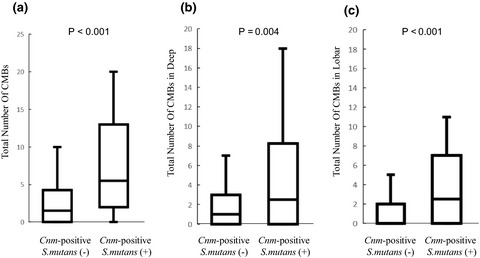
Patients with acute intracerebral hemorrhage (ICH) were prospectively registered at three hospitals. Patients with cnm-positive Streptococcus mutans had a higher frequency of diffusion-weighted imaging (DWI) hyperintensities and a higher number of cerebral microbleeds than those without cnm-positive S. mutans. This study found an association between the presence of cnm-positive S. mutans and DWI hyperintensities in patients with acute ICH.
Delirium in acute stroke: A prospective, cross-sectional, cohort study
- Pages: 1590-1600
- First Published: 21 January 2021
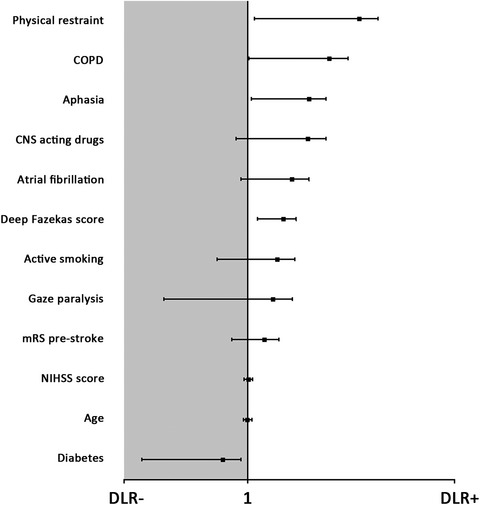
Delirium in stroke unit is frequent and is strongly associated with stroke-specific risk factors. The strongest predictors of delirium are aphasia, leukoencephalopathy, chronic obstructive pulmonary disease, and the early use of physical restraint. Care-related issues are relevant in precipitating delirium.
Gender differences in post-stroke functional outcome at discharge from an intensive rehabilitation hospital
- Pages: 1601-1608
- First Published: 09 February 2021
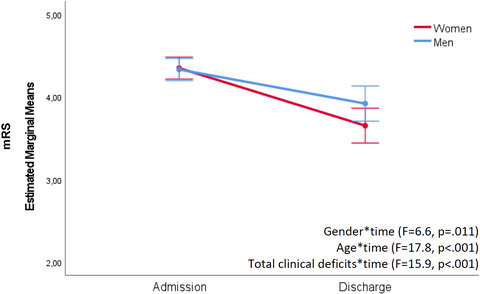
Gender differences in recovery after stroke rehabilitation are poorly investigated. In our study on admission to rehabilitation hospital, men and women were clinically similar. Functional recovery was similar despite women being older than men. At higher ages, the potential for recovery appears better in women.
Multiple Sclerosis
Quantifying the risk of disease reactivation after interferon and glatiramer acetate discontinuation in multiple sclerosis: The VIAADISC score
- Pages: 1609-1616
- First Published: 28 December 2020
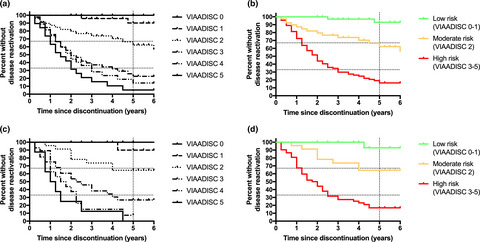
The objective of this study was to generate and validate a risk score for disease reactivation after disease-modifying therapy (DMT) discontinuation in relapsing multiple sclerosis. From two separate prospectively collected cohorts, a predictive score including three independent predictors of disease reactivation (age at discontinuation, magnetic resonance imaging activity at discontinuation, and duration of clinical stability) was generated. The resulting score was able to robustly identify patients at high (83%–84%), moderate (35%–38%), and low risk (7%) of disease reactivation within 5 years after DMT discontinuation.
A model for interrogating the clinico-radiological paradox in multiple sclerosis: Internuclear ophthalmoplegia
- Pages: 1617-1626
- First Published: 11 January 2021
Self-awareness in multiple sclerosis: Relationships with executive functions and affect
- Pages: 1627-1635
- First Published: 01 February 2021
Urban prevalence of multiple sclerosis in China: A population-based study in six provinces
- Pages: 1636-1644
- First Published: 04 February 2021
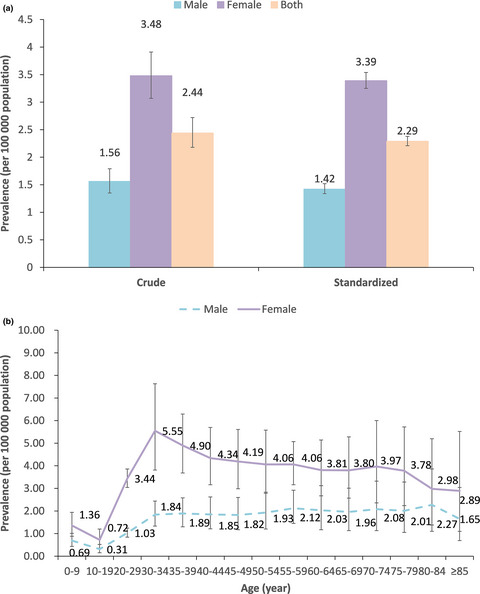
The crude prevalence of multiple sclerosis in urban China in 2016 was 2.44 per 100,000 population, with the prevalence of females higher than that of males. The standardized prevalence (based on 2010 Chinese census data) was 2.29 per 100,000 population. The prevalence in both sexes increased up to the age range of 30–34-years-old, and subsequently, the female prevalence declined with increasing age, but the male prevalence stabilized with increasing age.
Neuroimmunology
Pain, depression, and quality of life in adults with MOG-antibody–associated disease
- Pages: 1645-1658
- First Published: 10 January 2021
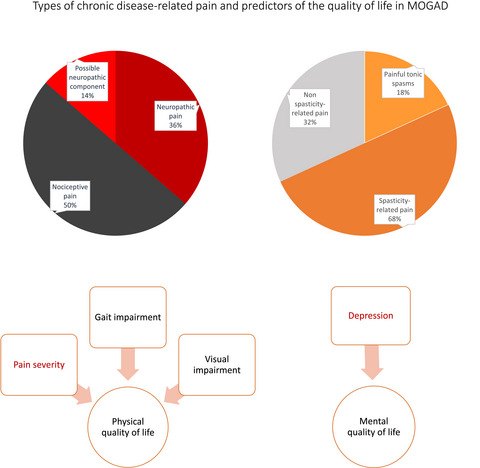
The study assessed features of pain, depression, and their impact on health-related quality of life (QoL) in myelin oligodendrocyte glycoprotein-antibody–associated disease (MOGAD). Half of the patients (51%) suffered from chronic MOGAD-related pain, including neuropathic, nociceptive, and spasticity-related pain, and 18 (42%) patients suffered from depression. Pain severity, visual impairment, and gait impairment independently predicted lower physical QoL, whereas depression was the only factor reducing mental QoL.
The long-term outcome of MOGAD: An observational national cohort study of 61 patients
- Pages: 1659-1664
- First Published: 02 February 2021
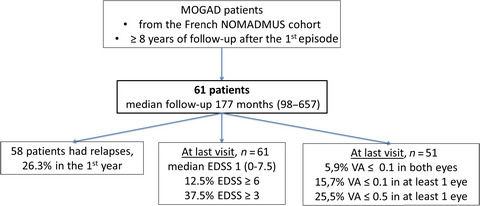
Sixty one patients with myelin oligodendrocyte glycoprotein antibody-associated disease were included, of whom 90.2% experienced at least one episode of optic neuritis. At last visit (median [range] follow-up of 177 [98–657] months), the median (mean; range) Expanded Disability Status Scale (EDSS) score was 1 (2.12; 0–7.5), 12.5% had an EDSS score ≥6 and 15.7% had visual acuity (VA) ≤0.1. Bilateral blindness (VA ≤0.1) was present in 5.9% of patients. No factor was associated significantly with a final EDSS ≥3 or with final VA ≤0.1. Overall long-term favourable outcomes were achieved in a majority of patients, but severe impairment, in particular visual damage, was not uncommon.
Neuro-oncology
The APOE ε4 allele in relation to pre- and postsurgical cognitive functioning of patients with primary brain tumors
- Pages: 1665-1676
- First Published: 20 December 2020
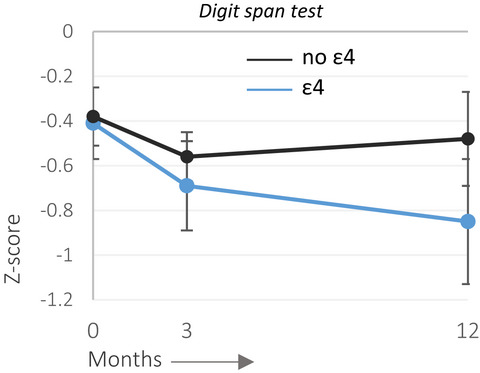
This prospective longitudinal study found no evidence for worse pretreatment cognitive function in APOE ε4-carrying as compared to non-carrying primary brain tumor patients. Cognitive performances over time up to 12 months after surgery also showed no statistically significant differences between carriers and non-carriers. APOE ε4’s effects on cognition should be further studied in large primary brain tumor samples with long-term follow-ups, where possible interactions with other genetic, clinical and behavioral factors should also be investigated.
Neuropathies
Genetic biomarkers for intravenous immunoglobulin response in chronic inflammatory demyelinating polyradiculoneuropathy
- Pages: 1677-1683
- First Published: 18 January 2021
We investigated whether genetic variation in six candidate genes was associated with the response to IVIg in CIDP patients. Variations in PRF1 and the promoter region of FCGR2B were associated with the response to IVIg in CIDP.
Cross-sectional area reference values for peripheral nerve ultrasound in adults: a systematic review and meta-analysis—Part I: Upper extremity nerves
- Pages: 1684-1691
- First Published: 01 February 2021
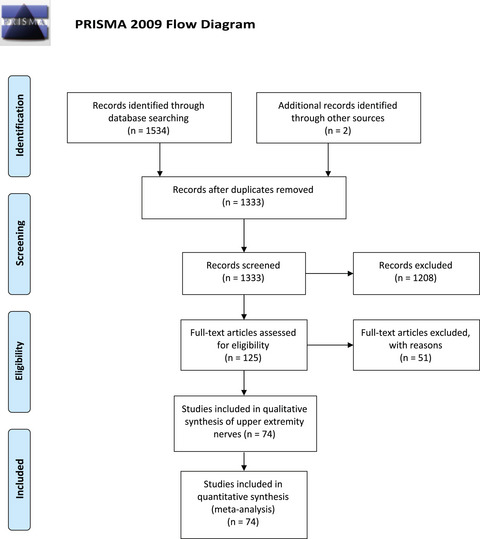
Reference values for cross-sectional area (CSA) of peripheral nerve ultrasound were published from several authors with varying heterogeneity. Here, the first meta-analysis on CSA reference values for the upper extremities with no or only low heterogeneity of reported CSA values in most nerve sites is provided.
Autonomic nervous system disorders
Immunomodulatory treatment in postural tachycardia syndrome: A case series
- Pages: 1692-1697
- First Published: 31 December 2020
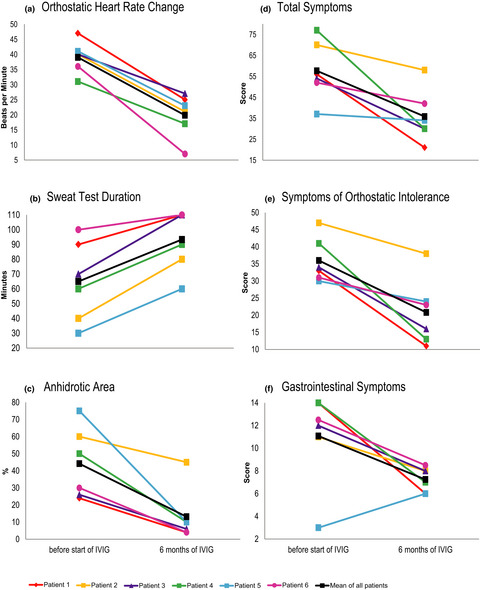
This case series reports the outcome of immunomodulatory treatment with intravenous immunoglobulin in patients with immune-mediated postural tachycardia syndrome. Six months of treatment resulted in improved subjectively perceived symptoms and also in an improvement of cardiovascular autonomic and sudomotor function. The initial poor tolerance was ameliorated by a reduction in infusion rate, and premedication with steroids and additional intravenous hydration.
Muscle and MNJ Disorders
Increased muscle echointensity correlates with clinical disability and muscle strength in chronic inflammatory demyelinating polyneuropathy
- Pages: 1698-1705
- First Published: 06 January 2021
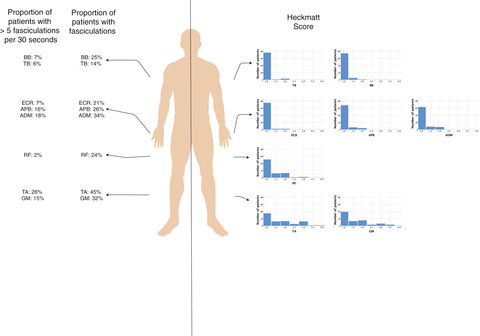
We evaluated muscle echointensity as a marker for secondary axonal damage in patients with chronic inflammatory demyelinating polyneuropathy (CIDP) using ultrasonography. Increased muscle echointensity, reflecting fibrosis and fatty infiltration due to secondary axonal damage, correlated to muscular strength and disability in a large cohort of CIDP patients.
Cancer in myasthenia gravis subtypes in relation to immunosuppressive treatment and acetylcholine receptor antibodies: A Swedish nationwide register study
- Pages: 1706-1715
- First Published: 11 January 2021
Headache
Long-term efficacy and safety of erenumab in migraine prevention: Results from a 5-year, open-label treatment phase of a randomized clinical trial
- Pages: 1716-1725
- First Published: 05 January 2021
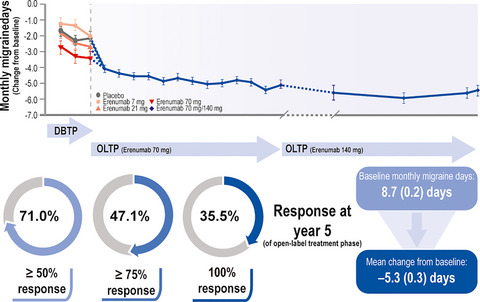
In this 5-year open-label treatment phase of erenumab in adult patients with episodic migraine, there was sustained efficacy including reductions in migraine frequency and monthly acute migraine-specific medication use. At year 5, monthly migraine days were reduced by 5.3 days from baseline (8.7 days), an average reduction of 62.3%, and monthly acute migraine-specific medication use was reduced 4.4 days from baseline (6.2 days) among patients using acute migraine-specific medication. No new safety signals were detected over the 5-year extended treatment period.
Chronic migraine: Genetics or environment?
- Pages: 1726-1736
- First Published: 11 January 2021
Vestibular disorders
Usability of the head impulse test in routine clinical practice in the emergency department to differentiate vestibular neuritis from stroke
- Pages: 1737-1744
- First Published: 31 December 2020
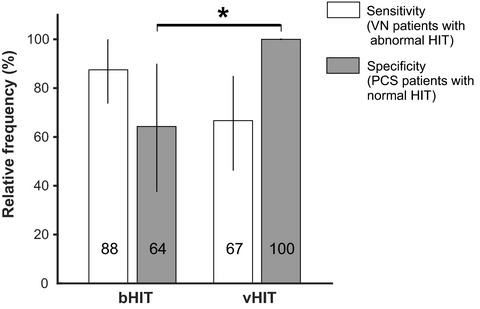
The bedside head impulse test (bHIT) performed by nonexpert clinicians in the emergency department has good sensitivity (88% of patients with vestibular neuritis were detected by an abnormal bHIT) but low specificity (only 67% of patients with posterior circulation stroke had normal bHIT result). The video-oculography–supported head impulse test had excellent specificity (100%), and thus, it did not misdiagnose a single stroke patient as vestibular neuritis, which makes it a very helpful tool in the assessment of patients with acute vestibular syndrome in the emergency department.
Pain
Greater small nerve fibre damage in the skin and cornea of type 1 diabetic patients with painful compared to painless diabetic neuropathy
- Pages: 1745-1751
- First Published: 01 February 2021
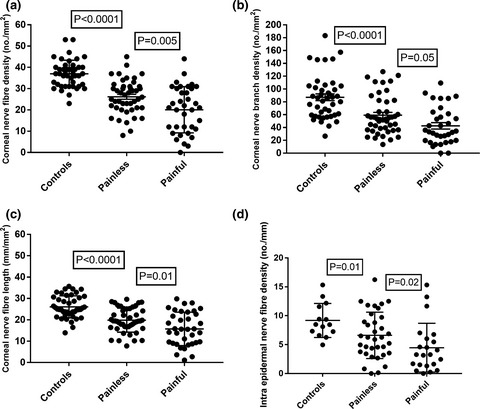
Damage to small nociceptive fibres may contribute to painful diabetic neuropathy. This study compared measures of large and small nerve fibres in patients with type 1 diabetes and painful or painless diabetic neuropathy. There is evidence of more severe neuropathy, particularly small fibre damage in the skin and cornea of patients with painful compared to painless diabetic neuropathy.
All neurologists
Functional motor disorders associated with other neurological diseases: Beyond the boundaries of “organic” neurology
- Pages: 1752-1758
- First Published: 09 December 2020
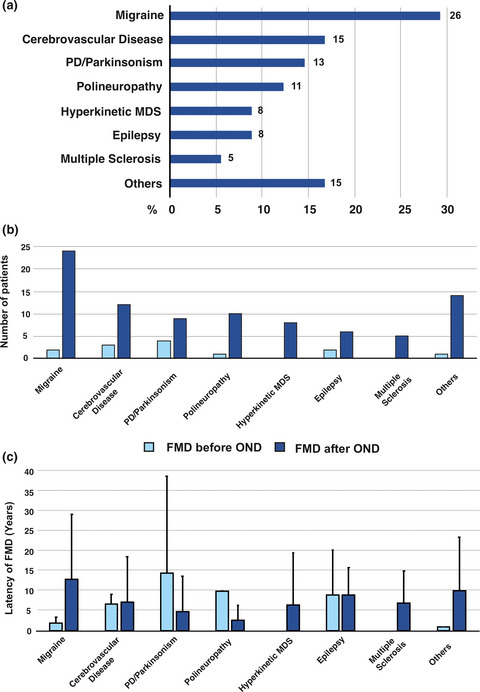
(a) Absolute frequency (and percentage) of functional motor disorders (FMDs) patients with one or more neurological disease. (b) Absolute frequency of patients with a neurological disease started before and after the definitive diagnosis of an FMDs. (c) Latency of FMDs onset (years) in patients with another neurological disease (OND).
Stroke
Vascular endothelial growth factor and poor prognosis after ischaemic stroke
- Pages: 1759-1764
- First Published: 11 November 2020
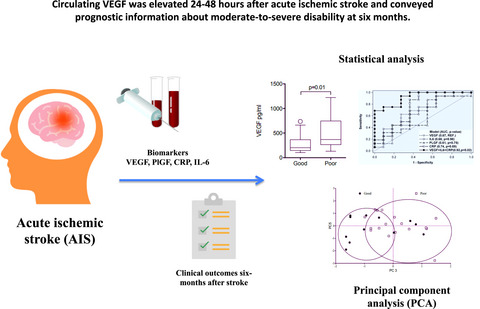
Chilean cohort study including forty-five patients with first-ever ischemic stroke shown that the circulating levels of vascular endothelial growth factor (VEGF) were elevated 24-48 hours after acute ischemic stroke and conveyed prognostic information about moderate-to-severe disability at six months.
Neuroimmunology
Dysphagia in neuromyelitis optica spectrum disorder and myelin oligodendrocyte glycoprotein antibody disease as a surrogate of brain involvement?
- Pages: 1765-1770
- First Published: 18 December 2020
Treatment-responsive primary autoimmune cerebellar ataxia in a patient with IgG and IgM anticerebellar antibodies
- Pages: 1771-1773
- First Published: 30 November 2020

We report a case of plasma exchange-responsive cerebellar ataxia in a patient with monoclonal gammopathy of undetermined significance. Incubation of the patient’s serum with organotypic (slice) cultures of rat cerebellum demonstrated uptake and intracellular binding of two different antineuronal autoantibodies: IgG antibodies reactive with cerebellar granule cell nuclei and IgM antibodies reactive with Purkinje cell cytoplasm. Neither antibody caused neuronal death, consistent with the patient’s excellent response to plasma exchange.
Vestibular disorders
The importance of the insular cortex for vestibular and spatial syndromes
- Pages: 1774-1778
- First Published: 03 December 2020
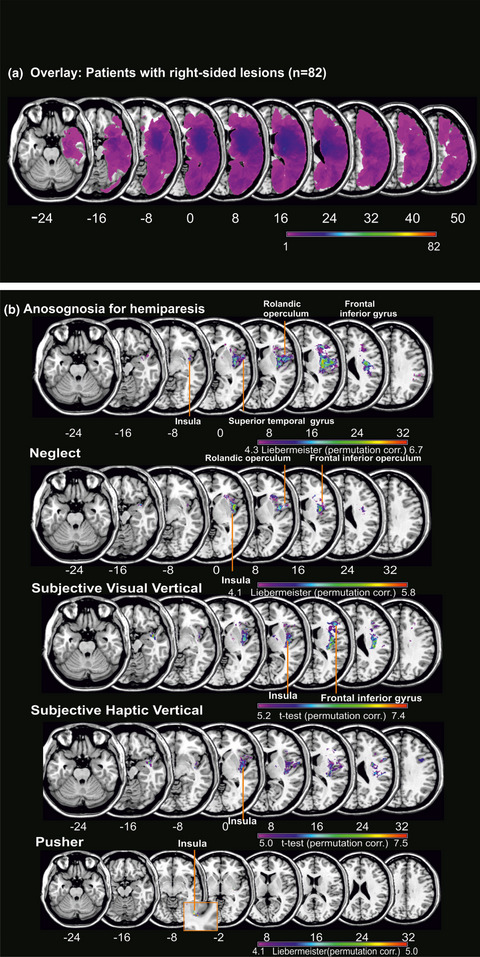
The present data of acute right-hemispheric stroke patients showed that the insular cortex was affected in tilts of the subjective visual vertical or of the subjective haptic vertical, pusher syndrome, visual neglect and unawareness of paresis (anosognosia for hemiparesis). Thus, the insular cortex is involved in (self-)perception and orientation within a three-dimensional space.
Signs of spatial neglect in unilateral peripheral vestibulopathy
- Pages: 1779-1783
- First Published: 28 December 2020
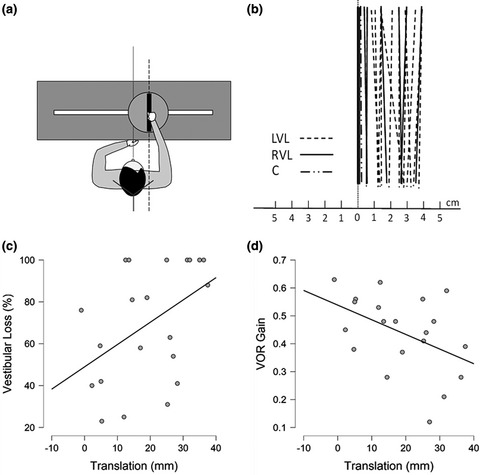
Unilateral chronic peripheral vestibulopathy leads to a spatial disturbance consisting in a rightward bias of body representation, whatever the side of the vestibular loss. Moreover, the subjective straight-ahead deviation is correlated with the vestibular loss intensity. Thus, our results suggest that patients with asymmetrical vestibular inputs present signs of spatial neglect.
Stroke
Cutaneous manifestations in Moyamoya angiopathy: A review
- Pages: 1784-1793
- First Published: 23 January 2021
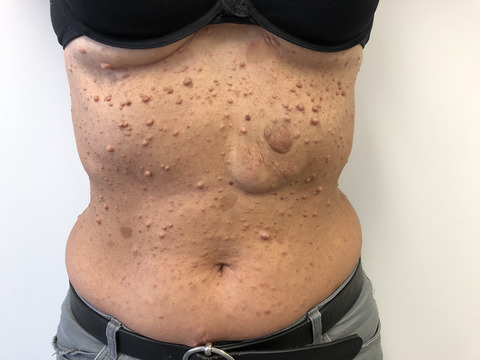
Moyamoya angiopathy (MA) is a rare progressive cerebrovascular disease resulting in early-onset strokes. It may be associated with other heritable or acquired conditions. Apart from the brain, other organ manifestations have also been described. Some skin manifestations have been reported, for example, café-au-lait spots, hypomelanosis of Ito, livedo racemosa, hemangiomas, and premature graying of hair. This review summarizes the cutaneous associations as well as the coincidental skin findings seen in MA patients. The cause of skin manifestations in MA is unknown, however, genetic associations such as Xq28 variations or dysfunctions in embryogenesis or molecular pathways could play an etiologic role.
Headache
Predictive model of headache at onset of first-ever ischemic stroke
- Page: e32
- First Published: 19 February 2021




